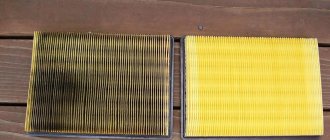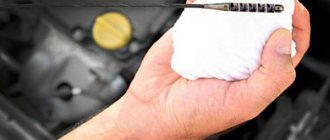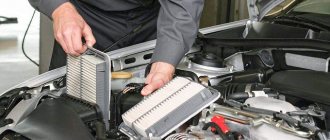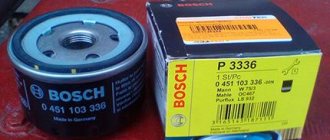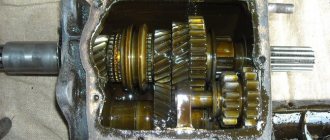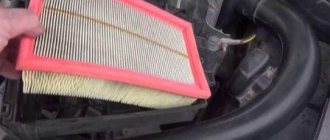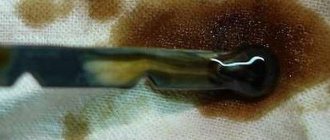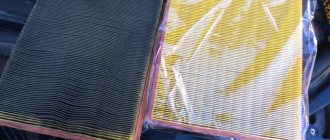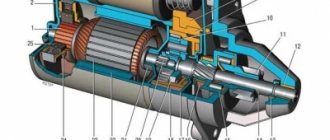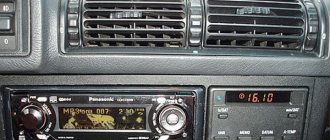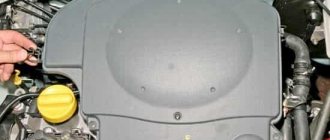05/21/2021 30 642 VAZ 2109
Author: Ivan Baranov
If during an inspection you find oil in the air filter of a VAZ 2109, this may indicate serious problems. In order to eliminate this malfunction, you first need to know not only the mileage of the car, but also a number of other factors.
In order to identify and eliminate this malfunction, you need to have a clear understanding of the air filter and understand what it is intended for.
[Hide]
Oil in the air filter housing, causes
The appearance of engine oil in the air filter housing indicates the occurrence of certain problems with the car engine.
In this case, the normal operation of the engine is disrupted: starting is difficult, problems arise with idling, dips appear when you press the gas pedal - in place and while moving (jerking, twitching). Oily spark plugs fail, the carburetor becomes clogged, power and throttle response decrease, and engine oil consumption increases. There is only one reason for engine oil getting into the air filter housing - an increase in pressure in the engine crankcase and, as a result, the release of oil from it through the crankcase ventilation system into the air filter housing.
Basic car engine malfunctions leading to the appearance of engine oil in the air filter housing
— The engine crankcase ventilation system is clogged
Gases from the engine crankcase are difficult to suck into the carburetor and air filter housing through a dirty crankcase ventilation system and oil separator. At the same time, the pressure in the crankcase increases greatly, causing oil particles to be intensively ejected into the filter housing.
In such a situation, it is enough to simply clean all elements of the crankcase ventilation system and restore normal gas circulation. Then replace the engine air filter filter element, spark plugs, and clean the carburetor (can be done without disassembling).
some elements of the crankcase ventilation system of engine 21083 of VAZ 2108, 2109, 21099 cars
— Engine piston rings are faulty
Perhaps stuck, broken or worn out. They pass gases from the combustion chambers into the engine crankcase. Excessive pressure is created there, which forces oil particles along with gases through the ventilation system into the filter housing.
Compression measurements and analysis of compression meter readings will help diagnose piston ring failure. Visually, the operation of an engine with faulty piston rings is visible by a strong stream of smoke coming out of the breather with pops. A working engine has virtually no smoke, or it is minimal and the stream of smoke is smooth and without pops.
Stuck rings can be decoked, worn or broken ones can only be replaced.
— In the early stages of oil leakage, you can operate the car without noticeable problems with engine operation (except that the spark plugs will fail more often and the carburetor with the filter element of the engine air filter will become clogged), but then the negative consequences will only increase.
— On the engines of rear-wheel drive VAZ cars, to “temporarily” solve the problem of engine oil escaping into the air filter housing, lower the crankcase ventilation hose from the breather under the engine. In this case, the oil exhaust dissolves in the atmosphere without entering the engine and without creating problems in its operation.
— Also, the release of engine oil into the engine air filter housing is accompanied by blue smoke from the muffler in all operating modes, oil leakage under the valve cover, oil filler cap, crankshaft and camshaft seals.
Where do traces of oil appear in the pipe?
At its core, there is only one reason why oil appears in the corrugation of the VAZ 2114 air filter - this is an excess of the normal gas pressure in the engine crankcase. As a result of this, along with the gases discharged from the crankcase into the pipe using a special tube (called a breather), suspended oil particles also enter. Once in the corrugation, they condense and settle on its walls.
There may be several reasons for excess pressure in the crankcase.
The main ones are:
- increased level of oil poured into the crankcase (higher than required);
- clogged or worn air filter;
- contaminated crankcase ventilation duct;
- an incorrectly functioning exhaust system (for example, the catalyst has melted);
- damaged main elements of the cylinder-piston group.
Such diverse reasons for the appearance of oil in the pipe are due to the fact that the intake and exhaust processes in a car are very closely related and are designed for the presence of a certain pressure in all components of the system. As soon as one of its elements is damaged, it immediately affects all the others.
Why does oil get into the air filter?
There are 4 most common reasons why oil leaks into the air filter:
- Heavily worn and coked piston rings. Because of this, excess lubricant is poorly removed from the cylinder walls, and some of it ends up in the crankcase.
- The throttle hose for crankcase gases is clogged with dirt.
- Clogged oil deflector drain. The remaining liquid cannot flow through it back into the crankcase, and the oil mixed with gases floods the air filter.
- Critical contamination of the filter element, due to which it loses its quality and does not allow air mass to pass inside the engine in sufficient volume. To compensate for the lack of air, the engine begins to suck it from the crankcase.
The result is always the same - the air filter fills with oil. What to do if motor lubricant is found in the cleaner?
Oil filter device
To better understand this reason, it is worth studying the structure of the oil filter. Most of them consist of a filter element and two valves. The first valve prevents oil from draining into the sump when the engine is not running. The second prevents the lubricating fluid from passing through the filter element during operation of the power unit. This is necessary at very high engine speeds or when the engine has not yet warmed up. Also, running oil bypassing the filter element is required when the latter is heavily clogged. This system does not allow the pressure to decrease. But the lubricant is not cleaned. But the performance of the motor remains normal.
This is how most filters are designed. But there are also those in which the oil will be filtered in any case. They have an additional filtration element in front of the bypass valve. But over time it becomes clogged. And then the oil can't pass through it. As a result, the pressure decreases and the warning light on the instrument panel lights up. Sometimes contamination of this element occurs long before the next oil change. If you continue to drive like this, the power unit may fail.
What to do if oil gets in
If oil flows into the air filter, this most often indicates a malfunction of the internal combustion engine. The deficiencies must be eliminated as quickly as possible before the engine fails. You can determine the reason why the air filter is in oil as follows:
- Check compression in all cylinders individually. 9-12 atm is considered normal. In this case, the compression values in different cylinders should be as close as possible - with a difference of no more than 1 atm. If the results obtained are below the minimum, this indicates serious problems with the engine;
- assess the color of the exhaust gases. If the exhaust is black or blue, the parts of the cylinder-piston group are worn out.
If the compression is normal and the smoke from the exhaust pipe is normal in color, the problem may not be with the engine. It is possible that oil is filling the air filter due to obstruction of the hoses for removing crankcase gases. In this case, it is enough to clean or replace the pipelines. If nothing has changed, you need to carefully check the internal combustion engine and related systems.
If you find that the engine air filter is oily, but you cannot postpone your trip, you can temporarily fix the problem and carry out a full repair after returning. To do this you need:
- remove the crankcase gas supply hose from the filter fitting;
- close the fitting;
- connect a longer hose to the crankcase ventilation so that the lower section of the tube is located below the level of the power unit.
This solution will allow you to use the car for some time without fear that the engine will suddenly fail. After completing the trip, you cannot postpone troubleshooting - major engine repairs will then be very expensive and take a lot of time.
Diagnostics
If on a carburetor or injector oil is thrown into the air cleaning device and the entire filter is in lubricant, the car owner needs to diagnose the problem. First of all, we recommend checking the functionality of the filter device itself. The service life of the element is 10-15 thousand kilometers, while the service life is affected by the pollution of the city in which the car is used. If the filter mechanism is relatively new, it is necessary to diagnose compression in the cylinders of the power unit.
Solving the problem using the example of VAZ
Let's consider a specific case - oil was found in the air filter of a VAZ-2109. The malfunction is always corrected taking into account the characteristics of the machine. There is no fundamental difference here compared to other cars - first you need to check the compression level and look at the color of the smoke. The procedure for working with carburetor and injection engines is the same
What to do if you find traces of oil in a VAZ air filter, watch this video:
Any spare parts for Volzhsky Automobile Plant cars are not in short supply and are inexpensive. Therefore, if oil is flowing into the VAZ air filter, it is much cheaper and faster to carry out diagnostics and replace the purifier or pipelines than to overhaul the power unit later.
Video “How to correctly install piston rings on a VAZ 2109”
The Auto Repair and Maintenance channel published a video that shows in detail the procedure for installing new piston rings in a VAZ 2109 car.
Do you have any questions? Specialists and readers of the AUTODVIG website will help you ask a question
Was this article helpful?
Thank you for your opinion!
The article was useful. Please share the information with your friends.
Yes (100.00%)
No
X
Please write what is wrong and leave recommendations on the article
Cancel reply
Rate this article: ( 4 votes, average: 5.00 out of 5)
Discuss the article:
How to avoid the problem (prevention, prevention)
Here are the basic preventive rules that will help avoid a situation where the appearance of oil in the air filter is associated with a malfunction of the elements of the cylinder-piston group:
- Do not miss the deadline for replacing fuel and lubricants. If the manufacturer recommends changing the engine oil every 15,000 km, it is better to change it even earlier, after 10,000 - 12,000 km. This will help to avoid risks associated with the operating mode of the vehicle, seasonality, and the quality of the lubricant;
- Always change not only the oil cleaner, but also the air cleaner at the same time as lubrication;
- fill the fuel tank only with high-quality fuel from trusted manufacturers;
- Buy only certified engine lubricant.
By observing these simple requirements, you can not only improve the quality of the internal combustion engine, but also increase its service life. Additionally, a universal oil trap can be installed on the crankcase gas supply line. This part is inexpensive, but can provide guaranteed protection against lubricant getting into the filter element.
We figured out why the air filter may end up in oil and what needs to be done in this case. It is important to remember that if oil leaks into the air filter, in most cases the problem lies in the condition of the engine, and troubleshooting cannot be delayed. It is also recommended to inspect the air purifier more often - this procedure will take a few minutes, but you will be able to notice a malfunction in a timely manner and take the necessary measures.
Lubrication system VAZ 2109 Lada Samara
- Repair manuals
- Repair manual for VAZ 2109 (Lada Samara) 1987+.
- Lubrication system
11.4.1 Lubrication system Before you begin: disconnect the cable from the “–” terminal of the battery. Drain the engine oil and remove the generator drive belt. Warning After removing the camshaft drive belt, do not turn the camshaft and crankshafts, as this may cause the pistons to... 11.4.2 Removing the oil pump Before you begin: disconnect the wire from the “–” terminal of the battery. Drain the engine oil and remove the generator drive belt. Warning After removing the camshaft drive belt, do not turn the camshaft and crankshafts, as this will cause the pistons...
11.4.3 Disassembly and troubleshooting of the oil pump Note The body and cover of the oil pump must be ground at a service station that has special equipment. PERFORMANCE ORDER 1. Unscrew the six bolts securing the cover and remove it from the pump body. 2. Remove the pump gears from the housing. 3. Remove using...
11.4.4 Installing the oil pump PERFORMANCE ORDER 1. Install the oil pump in the reverse order of removal, taking into account the following. For tightening torques in threaded connections, see Appendix 3. 2. When installing the pump, lubricate the working edge of the oil seal with engine oil. 3. When installing the oil receiver, lubricate the seal...
11.4.5 Replacing the oil filter and engine oil Note If you do not have a special wrench and you cannot unscrew the filter by hand, pierce the filter housing with a screwdriver and use it as a lever. Replacement frequency: every 15,000 km Motor oils: LUKOIL-Arctic (5W-30, 5W-40; SG/CD); "YAR-Marka Super" (5W-30,...
Filter Features
To determine the reasons for the presence of oil in the filter, the first step is to find out about the features of its operation and functions.
Some people mistakenly believe that VF is an ordinary consumable that does not require special attention. Because of this, checking the condition of the air filter is extremely rare. Sometimes it comes to the point that when dismantling the element, drivers find something like an old dirty rag instead of a filter.
For efficient combustion of the air-fuel mixture in a carburetor engine, it is necessary that the amount of air exceeds the amount of fuel by approximately 15-20 times.
To prevent such a nuisance, which threatens serious engine damage, an air filter (AF) is installed on the VAZ 2109. In addition to the main function of cleaning, the filter also serves as a muffler and fuel cooler.
Brand new filter element
Replacing the filter
The air filter can be changed independently or at a service station. To do this you will need:
- open the hood, find a black box next to the engine, inside of which the filter element is located;
- unscrew the fasteners, carefully remove the top part so that debris does not spill out during the procedure;
- remove the filter element;
- remove dirt from the inside of the case;
- install a new filter with the sealing surface facing up;
- close the upper part of the housing and secure it tightly.
In order to avoid serious engine damage and delay its repair, you need to purchase quality products. Oil, gasoline, filter should not be purchased from unknown suppliers. Saving on materials provokes engine breakdown; it costs more than replacing a filter or buying good oil or gasoline.
Why does oil get in?
To understand why oil particles appear in the air filter, consider the following carburetor operation algorithm:
- When fuel burns, crankcase gases are formed;
- In the normal state of the engine, they are completely removed from the cylinders;
- If the engine is worn out, coked, or has other problems, some of the crankcase gases remain inside;
- This provokes the creation of high blood pressure;
- Due to increased pressure, the condition of the seals deteriorates and they cannot perform their functions properly;
- If the oil seals are damaged, oil consumption increases and it begins to flow into the VF.
Oil in VF
There are several main reasons why the VF becomes contaminated with oil.
Cause
Nuances
The piston rings of the power unit are worn out
This leads to a disruption in the proper functioning of the collection of excess lubricant that enters the crankcase from the cylinder. Pressure increases, oil is squeezed out by the oil deflector and vent valve. A clogged oil deflector drain does not allow the lubricant to return back to the crankcase, so it escapes along with the gases
The crankcase gas outlet paths are clogged
If the paths are clogged, gases from the crankcase cannot fully escape the throttle limits. As a result, we get lubricant and gases in the air filter
Air cleaning material is clogged
The engine does not receive enough air, so it begins to suck it in from all available sources. Not rarely - from the crankcase. As a result, it turns out that the filter is flooded with oil.
Piston rings
Repair work
If you discover the presence of oil in the air filter of your VAZ 2109, you should definitely take immediate action.
Ignoring the presence of oil in the VF can lead to serious damage, including the need for major engine repairs. I don’t even want to imagine how much it will cost.
- Check the compression of your engine. If there are problems with it, the piston rings or the piston system are worn out, this can be determined by blue or dark smoke. Plus, the level of lubricant, that is, oil, will constantly drop.
- If the compression test shows that everything is fine, then you can breathe a sigh of relief. This suggests that the problem is not that complex.
- Most likely, the filter element is clogged or the hoses for removing crankcase gases from the crankcase are clogged. You will have to change the filter, wash or replace the output hoses.
The most important recommendation is periodic maintenance of all engine components and auxiliary mechanisms. It is better to prevent a disease than to eliminate its consequences later.
Compression check
After checking the compression, you can breathe a sigh of relief or worry, since the cost of the repair depends on the result.
Impaired compression often causes the presence of oil in the VF, and also causes a number of other problems.
Compression check
To work you will need:
- Compressometer;
- A rag in oil, which you will use to determine the compression stroke;
- Adapter for spark plug holes. It is used when checking the combustion chamber for leaks;
- Compressor.
Now let's start checking.
- Warm up the engine to operating temperature, then turn off the fuel supply.
- In the case of a carburetor, you need to remove the hose, clamp or squeeze it with something, or lower it into a container.
- If you have an injector, remove the fuel pump fuse, start the engine and let it run. As soon as the fuel in the fuel rail runs out, it will stall on its own.
- Disconnect the ignition system by removing the center wire from the distributor (on the carburetor). The crankshaft position sensor at the injector must be disconnected.
- Remove all debris from the spark plug wells so that it does not end up inside the cylinders. Unscrew the spark plugs.
- Insert the compression gauge fitting while an assistant starts the engine. The starter should rotate the engine until the pressure gauge needle stops in one position.
- By analogy, measurements are carried out on each cylinder, the results are recorded on paper.
- To calculate ideal compression, use the formula - 1.2 * Compression ratio.
See your owner's manual for the compression ratio of your engine. Please also note that measurements may have some error.
What you need to know about verification
- If the indicator is 12 atmospheres, this indicates that your engine is almost in perfect condition.
- When checking the compression on a cold engine, the compression readings will be significantly lower. Perform the test only on the engine at operating temperature.
- If the battery is partially discharged, the test data will also not be accurate.
- The increase in compression occurs due to the combustion of oil in the cylinders.
Why does oil get into the air filter?
Car enthusiasts inspect the air purification element, as a rule, only during its reinstallation. Sometimes it happens that they detect oil in the air filter. A legitimate question immediately arises: where did it come from? After all, it would seem, what is the connection between the oil channels and the air filtration unit?
And the connection is this: oil can penetrate into the air filter through the channel connecting the engine crankcase to the air purifier housing. This channel is structurally created for crankcase ventilation, which cannot be avoided. However, it is preceded by an oil deflector and a valve. Another thing is why the oil particles do not remain inside the crankcase? It is from the crankcase that they, bypassing the oil deflector with the valve, penetrate where they should not. Based on this, you can understand the reasons why oil sometimes gets into the filter. They are like that.
- Excessive wear on piston rings. It leads to the fact that during combustion some of the gases enter the crankcase from the cylinders. Excessive pressure is created, which squeezes oil particles through barriers, namely through the oil deflector and valve, directly inside the air purifier housing. In this case, the exhaust gases have a black and also blue tint.
- The oil deflector drain is clogged. This case leads to some of the oil being thrown upward, since the outflow path is blocked.
- The channel that discharges crankcase gases under the throttle valve is clogged. In this case, excess crankcase gases, together with oil particles, also reach the walls of the filter element directly through the throttle valve.
- The cleaning element itself is too clogged. Therefore, the engine more actively “sucks” air from the crankcase, again with oil particles, which causes an oil product to appear on the cleaning element.
- Excess of petroleum product filled during replacement. There is so much of it inside the engine that the excess also breaks through in drops to the body of the air cleaning unit.
- The breather, that is, the crankcase valve, allows droplets of oil to pass through due to excess pressure.
- The oil seals, that is, the oil seals that hold the lubricant above the valves, have leaked; it breaks through into the combustion chamber, which creates excess pressure, which also drives the oil product to the purifier.
The road is clear
Now let’s take a closer look at how this happens, how the oil gets from the crankcase to the filter.
- Due to excess pressure, oil particles break out of the crankcase.
- Initially they get inside the oil deflector.
- Next, overcoming the valve, they “move” inside the pipe, which is connected to the purifier body.
- Result: oil traces appear in the filter.
As you can see, everything is quite obvious.
Now let’s look at diagnostics, as well as correction of typical situations using specific examples with cars. That is, let's see how the search for the cause of oil particles getting into the filter should go.
How to treat it
Here’s a common case: a car enthusiast discovered oil in the air filter of a VAZ 2109. You need to figure out what the essence of the problem is. If you do not pay attention to the situation, the consequences can be disastrous, including major engine repairs.
To find out the answer to the car enthusiast’s sacramental question – “why does it throw oil directly into the air filter?” – initially we prepare everything that may be useful to us:
- a pressure gauge, more precisely, a compression gauge, the simplest one equipped with a flexible tube with a thread at the end;
- set of wrenches;
- spark plug key;
- rags, gasoline, brush.
To find out why the engine drives oil into the filter, we proceed as follows.
- We look at the exhaust smoke – we don’t notice a black or blue tint. This means that stuck piston rings can most likely be ruled out.
- We check the oil level with a dipstick - it turns out that there is no excess oil product either.
- We measure the compression of the cylinders. To do this, we unscrew the spark plugs on a warm engine, according to the relevant instructions attached to the compression gauge, take measurements on each of the cylinders, and check the passport data. We find out that the compression corresponds to the standard specified in the car’s registration certificate.
- We notice that there is also oil in the filter pipe, which extends from the breather.
- We dismantle the breather, that is, the crankcase valve. To do this, first remove the valve cover.
- Remove two bolts from the valve cover.
- We take it out, then clean the stack of oil deflector screens with gasoline. We also wash the breather itself with gasoline.
- We perform assembly in reverse order.
This is how you can understand why the VAZ 2109 has oil in the filter, and then fix the problem. Let us add that some car owners simply remove the breather tube from the air intake duct, then lower it down under the engine. However, this serves only as a temporary measure and does not in any way solve the problem itself.
Next we consider another typical case. Suppose there is oil in the air filter of a VAZ 2110 car. We have the following at hand:
- compression gauge;
- spark plug key;
- set of keys, screwdrivers.
As described earlier, we first look at the exhaust and also measure the compression. If the compression is low, we recommend disassembling, diagnosing and repairing the engine. But, let’s say, here, too, the compression turned out to be normal. Then we proceed as follows.
- We find out that there are no deposits at the breather pipe, and that the air-cleaning element has been replaced recently.
- We remember that the engine usually has difficulty starting.
- As an option, we clean the throttle assembly.
- To do this, first remove the decorative engine cover.
- We dismantle the air pipe ventilation hose and find traces of oil inside it. The throttle body's ventilation duct is probably clogged.
- Having loosened the clamps, remove the hoses of the throttle heating channel, as well as the gas tank ventilation system.
- We dismantle the cable and also unscrew the two nuts of the throttle assembly.
- We thoroughly wash the removed throttle assembly with gasoline or a special product with partial disassembly.
Why does oil get into the air filter?
Car enthusiasts inspect the air purification element, as a rule, only during its reinstallation. Sometimes it happens that they detect oil in the air filter. A legitimate question immediately arises: where did it come from? After all, it would seem, what is the connection between the oil channels and the air filtration unit?
- The road is clear
- How to treat it
- How much does such a renovation cost today?
And the connection is this: oil can penetrate into the air filter through the channel connecting the engine crankcase to the air purifier housing. This channel is structurally created for crankcase ventilation, which cannot be avoided. However, it is preceded by an oil deflector and a valve. Another thing is why the oil particles do not remain inside the crankcase?
It is from the crankcase that they, bypassing the oil deflector with the valve, penetrate where they should not. Based on this, you can understand the reasons why oil sometimes gets into the filter. They are like that.
- Excessive wear on piston rings. It leads to the fact that during combustion some of the gases enter the crankcase from the cylinders. Excessive pressure is created, which squeezes oil particles through barriers, namely through the oil deflector and valve, directly inside the air purifier housing. In this case, the exhaust gases have a black and also blue tint.
- The oil deflector drain is clogged. This case leads to some of the oil being thrown upward, since the outflow path is blocked.
- The channel that discharges crankcase gases under the throttle valve is clogged. In this case, excess crankcase gases, together with oil particles, also reach the walls of the filter element directly through the throttle valve.
- The cleaning element itself is too clogged. Therefore, the engine more actively “sucks” air from the crankcase, again with oil particles, which causes an oil product to appear on the cleaning element.
- Excess of petroleum product filled during replacement. There is so much of it inside the engine that the excess also breaks through in drops to the body of the air cleaning unit.
- The breather, that is, the crankcase valve, allows droplets of oil to pass through due to excess pressure.
- The oil seals, that is, the oil seals that hold the lubricant above the valves, have leaked; it breaks through into the combustion chamber, which creates excess pressure, which also drives the oil product to the purifier.
Also find out why the oil pressure light is on at idle and how to properly check the engine oil level.
The road is clear
Now let’s take a closer look at how this happens, how the oil gets from the crankcase to the filter.
- Due to excess pressure, oil particles break out of the crankcase.
- Initially they get inside the oil deflector.
- Next, overcoming the valve, they “move” inside the pipe, which is connected to the purifier body.
- Result: oil traces appear in the filter.
As you can see, everything is quite obvious.
Now let’s look at diagnostics, as well as correction of typical situations using specific examples with cars. That is, let's see how the search for the cause of oil particles getting into the filter should go.
How to treat it
Here’s a common case: a car enthusiast discovered oil in the air filter of a VAZ 2109. You need to figure out what the essence of the problem is. If you do not pay attention to the situation, the consequences can be disastrous, including major engine repairs.
To find out the answer to the car enthusiast’s sacramental question – “why does it throw oil directly into the air filter?” – initially we prepare everything that may be useful to us:
- a pressure gauge, more precisely, a compression gauge, the simplest one equipped with a flexible tube with a thread at the end;
- set of wrenches;
- spark plug key;
- rags, gasoline, brush.
To find out why the engine drives oil into the filter, we proceed as follows.
- We look at the exhaust smoke – we don’t notice a black or blue tint. This means that stuck piston rings can most likely be ruled out.
- We check the oil level with a dipstick - it turns out that there is no excess oil product either.
- We measure the compression of the cylinders. To do this, we unscrew the spark plugs on a warm engine, according to the relevant instructions attached to the compression gauge, take measurements on each of the cylinders, and check the passport data. We find out that the compression corresponds to the standard specified in the car’s registration certificate.
- We notice that there is also oil in the filter pipe, which extends from the breather.
- We dismantle the breather, that is, the crankcase valve. To do this, first remove the valve cover.
- Remove two bolts from the valve cover.
- We take it out, then clean the stack of oil deflector screens with gasoline. We also wash the breather itself with gasoline.
- We perform assembly in reverse order.
This is how you can understand why the VAZ 2109 has oil in the filter, and then fix the problem. Let us add that some car owners simply remove the breather tube from the air intake duct, then lower it down under the engine. However, this serves only as a temporary measure and does not in any way solve the problem itself.
Next we consider another typical case. Suppose there is oil in the air filter of a VAZ 2110 car. We have the following at hand:
- compression gauge;
- spark plug key;
- set of keys, screwdrivers.
As described earlier, we first look at the exhaust and also measure the compression. If the compression is low, we recommend disassembling, diagnosing and repairing the engine. But, let’s say, here, too, the compression turned out to be normal. Then we proceed as follows.
- We find out that there are no deposits at the breather pipe, and that the air-cleaning element has been replaced recently.
- We remember that the engine usually has difficulty starting.
- As an option, we clean the throttle assembly.
- To do this, first remove the decorative engine cover.
- We dismantle the air pipe ventilation hose and find traces of oil inside it. The throttle body's ventilation duct is probably clogged.
- Having loosened the clamps, remove the hoses of the throttle heating channel, as well as the gas tank ventilation system.
- We dismantle the cable and also unscrew the two nuts of the throttle assembly.
- We thoroughly wash the removed throttle assembly with gasoline or a special product with partial disassembly.
We also add that when a VAZ 2112 has oil in the filter, you need to act in the same way.
